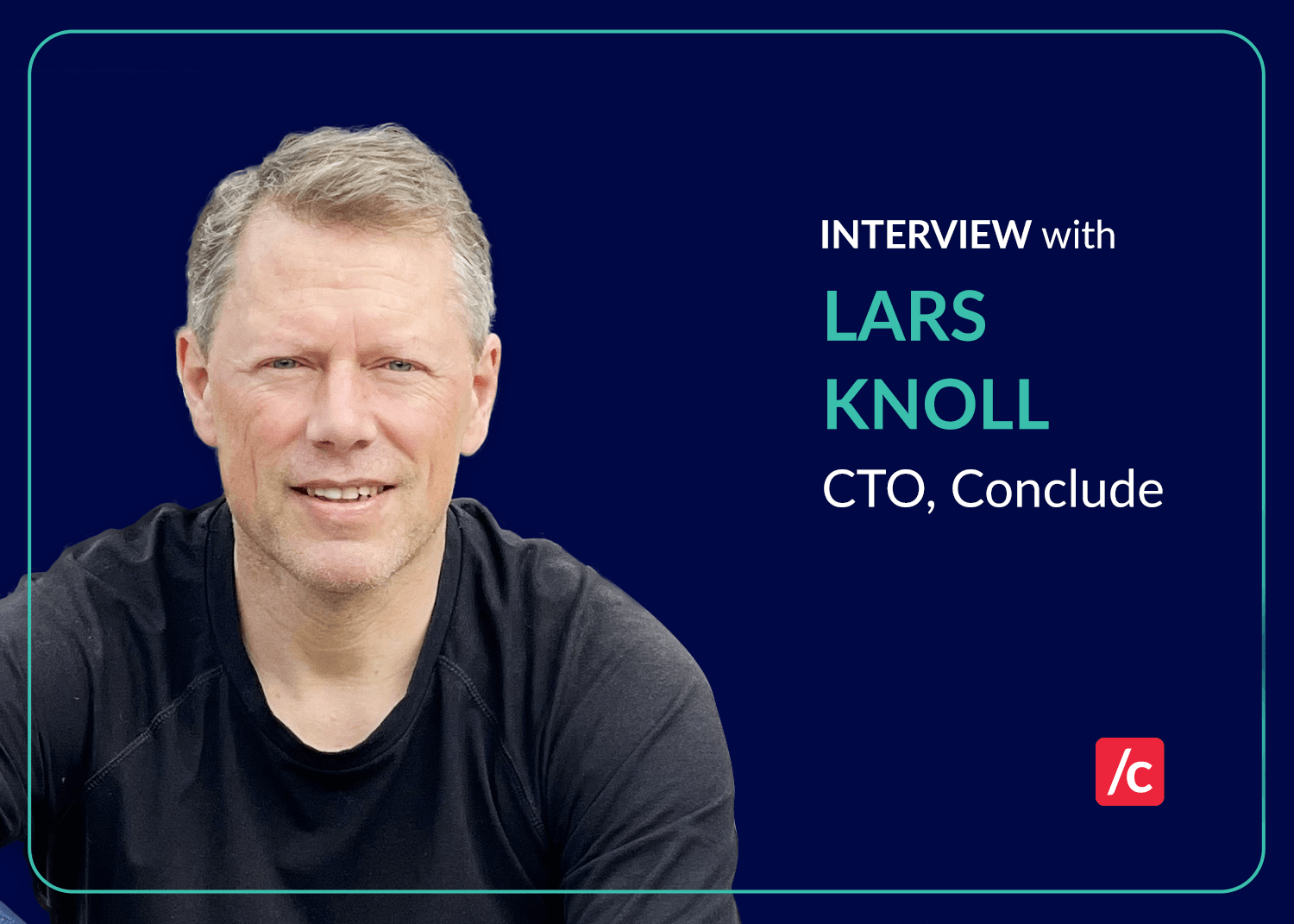
February 15, 2024
Lars Knoll is on a mission to make communication within and between companies and customers easier than ever by integrating chat platforms Slack and Microsoft Teams with popular tools like Jira and Zendesk. With over two decades in tech, his journey from studying molecular physics to leading software development at app framework company Qt, is nothing short of impressive.
His appointment as Conclude’s CTO means he’s back to collaborating with Qt creator and CEO of Conclude, Haavard Nord. Together, they’re tackling the challenge of making workplace communication smoother, by structuring conversations inside chat programs and helping to reduce the cognitive strain of context switching.
The challenge, as Knoll puts it, is not just technical but deeply rooted in the corporate culture of communication. “It’s a difficult problem to solve,” he admits, highlighting the reluctance of companies to invest in solutions for a cost that is “both hidden and spread out over time.”
Lars explains that the issue of switching between different communication tools is like dealing with “tiny paper cuts” – small but significant problems that add up, affecting productivity and focus.
He believes the solution is to confront these hidden costs directly, showing companies the value of a unified and efficient communication system.
Lars is Appointed to Conclude’s Board
After more than 20 years at Qt, Lars decided to join Conclude as CTO in 2022. His extensive experience from Qt’s early days to its success in the embedded market equipped him with a unique perspective on technology’s role in solving real-world problems. “Joining Conclude was about bringing my experience full circle, from developing the foundational technology at Qt to tackling the complexities of digital communication,” Lars states.
And with his recent appointment to Conclude’s Board, he is in a strong position to help drive the company forward.
From Physicist to Tech Innovator
Lars’s journey from academia to the vanguard of the tech industry is one of adaptation, innovation and a curiosity for simplifying complex problems using technology.
His academic roots studying physics at Heidelberg University in Germany, and subsequent PhD in molecular physics at the Max Planck Institute, provided a strong foundation in analytical thinking and problem-solving. Reflecting on this, Lars notes, “My time in physics was crucial in shaping my approach to technology. It’s where I learned the importance of precision and innovation.”
During his PhD, he ventured into the world of software by contributing to the KDE project, specifically working on the KHTML browser engine. This work would later become the foundation for WebKit, the engine powering most of today’s browsers. It was a pioneering effort that underscored Lars’s ability to influence the world of tech.
Lars recalls, “Working on KHTML was my first step into open-source projects. It was exciting to see our work evolve into something as impactful as WebKit.”
After completing his PhD, Lars joined Trolltech in Norway, the company founded by Haavard Nord and Eirik Chambe-Eng. At Trolltech, (home to Qt), he delved into C++ development, focusing on creating tools for other developers. His work was instrumental in making the cross-platform toolkit Qt a success.
Their aim was to ensure the software could run seamlessly across different operating systems, a vision that Lars contributed to with his expertise in internationalization and text handling among other areas. “The goal with Qt was always about making developers’ lives easier, ensuring that software could run seamlessly across platforms,” Lars explains.
His leadership and technical skills came to the forefront when he took on management responsibilities, eventually becoming the global head of R&D. Although, as Lars explains, he always held a stronger interest in the technical side: “I realized that my passion was in solving technical challenges, not in managing large teams. This led me to the role of what was then called Chief Architect and later CTO, where I could focus on innovation,” he shares.
The acquisition of Qt by Nokia in 2008 and their subsequent focus on the embedded segment (from coffee machines to cars), were important moments: “The embedded segment was a natural evolution for Qt, tapping into the demand for sophisticated user interfaces across devices. It was about extending our reach beyond traditional computing platforms,” Lars remarks.
Smoother Communication and Reduced Context Switching
At the heart of Conclude’s mission is a commitment to streamlining the complexities of communication in the modern workplace. Two of the most pressing issues are: the fragmentation of chat programs (specifically between Slack and Microsoft Teams), and the hidden cost and inefficiency of context switching for knowledge workers.
“The core problem we’re tackling at Conclude is the fragmentation of communication tools,” Lars explains. “In many companies, you’ll find teams using Slack, others using Microsoft Teams, and often there’s no easy way for these platforms to talk to each other. It creates silos of information that hinder collaboration and efficiency.”
This fragmentation is more than just a nuisance; it represents a significant barrier to productivity. Conclude’s approach to solving this issue is to focus on creating bridges between popular communication platforms to enable a unified communication experience, using no-code workflow apps and artificial intelligence to make teams more efficient.
“Every time you switch from one application to another, there’s a cognitive cost,” Lars continues. “It might seem minor, but over time, these costs add up, significantly impacting productivity. Our goal is to minimize this by integrating communication tools and workflows (like Slack and Jira or Microsoft Teams and Zendesk) in a way that reduces the need to switch constantly.”
Conclude’s solutions are designed with the understanding that effective communication is the backbone of any successful organization.
“We’re not just building software; we’re reimagining how communication can flow more naturally in the workplace,” Lars states. “For example, our work on integrating Slack and Microsoft Teams is about more than just connecting two platforms; it’s about creating a seamless experience where information is easily accessible, regardless of the tool you’re using.”
What is Conclude Doing Differently?
Although there are several companies trying to solve the challenges of connecting different programs (Zapier is one well-known tool), Conclude’s solution is different. So why aren’t there more solutions on the market?
“I think it’s an interesting question,” Lars responds. “First of all, it is not an easy challenge or problem to solve. Bringing those systems together – even though superficially they look relatively similar – and synchronizing data between them, is not really easy.”
Technically speaking, it requires quite a bit of work to get all the infrastructure in place. This is to ensure that “you don’t end up sending messages in a loop back and forth when dealing with those different systems,” he smiles. “So yes, the infrastructure is one piece. The other piece is probably that companies don’t tend to do that themselves for their own internal use, because it’s just – as I said – way too much work.”
Conversational Ticketing and Conclude’s Product Roadmap
Looking ahead, the company is not just focused on solving today’s communication challenges but also anticipating the evolving needs of the modern workplace. This year, Conclude is set to introduce a series of product developments aimed at further simplifying and enhancing internal and external company communication.
“From a product perspective, we currently have Workflows on Slack where you can basically structure discussions and activities, and we’re bringing that over to Microsoft Teams right now,” he explains. The goal is to have the Microsoft Teams piece in place by Q2, 2024.
“We are finishing off a couple of details around our bridge between Slack and Microsoft Teams to make that fully seamless,” he continues. “The bridge currently supports synchronizing channels between the two and we are also working on allowing private chats and group chats to be synchronized and created between Slack and Microsoft Teams.”
An additional piece for Conclude is not only around managing internal communication, but also using conversational ticketing solutions to manage external customer communication and support.
“The key phrase here is conversational ticketing,” he continues. “And although it can also be internal customers inside the company, we want to make it really easy for those tickets to end up in your chat system.”
With conversational ticketing, chats can happen inside a channel in real-time, so you are closer to your customers than when using a regular email based support channel. He explains: “You can also create different tickets out of messages. It could be a bug report, an incident or some other type of support request. We’re seeing that lots of companies are using Zendesk to handle ticketing, and we’re integrating that as well.”
These developments are part of Conclude’s broader vision to transform the way companies communicate. The company’s product roadmap is ambitious, reflecting a commitment to innovation and a deep understanding of the communication challenges facing modern workplaces.
With Lars as CTO, alongside Haavard, the company is not just reacting to current trends but actively shaping the future of workplace communication.
“As we move forward, our focus will remain on breaking down the barriers to effective communication,” Lars concludes. “Whether it’s with useful integrations, structured conversations, or reimagining customer interactions, we aim to make communication as seamless and efficient as possible. That’s the promise of Conclude, and it’s a future we’re excited to build.”


